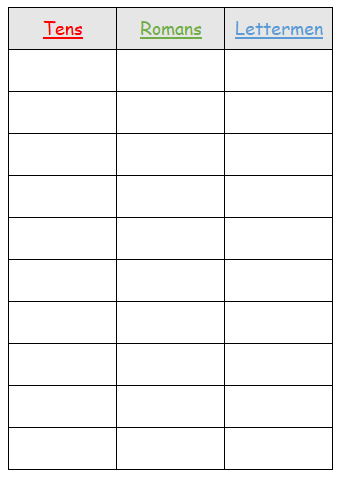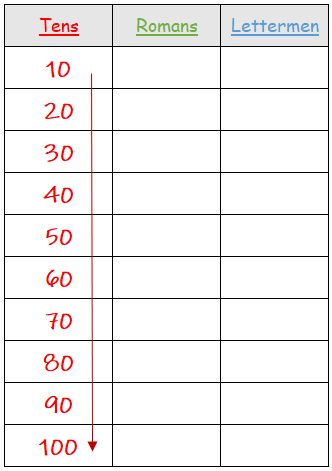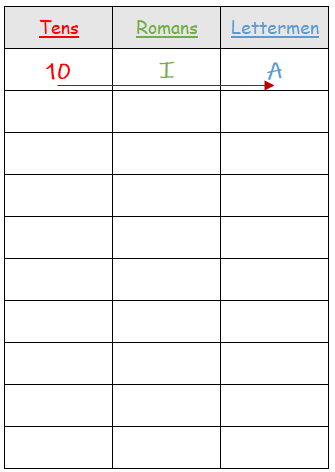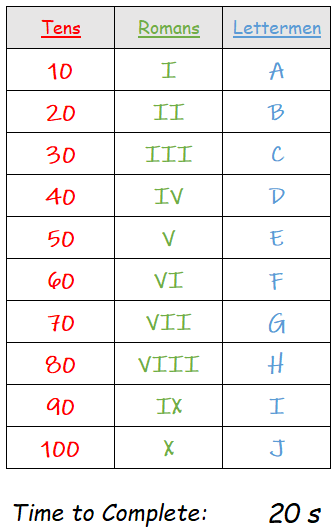A simple game to illustrate the cost of task-switching *
The title of this post is a terrible play on words. Every time I think about it, I’m reminded of the opening lines of Mark Antony’s funeral oration. It’s cool if you don’t agree with the title. Lend me your ears anyway…
Multi-tasking via Task-Switching is a costly practice. This game can be used to illustrate this point with things you can probably find readily available in your desk or office-supply closet. The material is presented in 2 parts. Part 1 reveals the exercise in its most basic form. Part 2 expands on the original premise to learn even more…
Part 1 – The Basics
The Players will create a grid represented by writing a combination of numbers and letters following an easily defined pattern. Start with the following grid:

When complete:
- The first column will contain a list of NUMBERS, written in RED INK, representing the numbers from 10 to 100, in increments of 10
- The second column will consist of ROMAN NUMERALS from 1 to 10, written in GREEN INK
- The third column will contain a list the first 10 CAPITAL LETTERS in the alphabet, written in BLUE INK.
“Tens, Romans, and Lettermen” vs. “Friends, Romans, Countrymen…”, get it? If that made you cringe, imagine what it’s like inside my head. 😛
Rules of the Game
Rule #1: MATERIALS – Each Player will need access to three pens (Red, Green, & Blue) and something to write on such as a Flip Chart, Whiteboard, or Piece of Paper
Rule #2: WIP LIMIT – A player is only allowed to hold one pen at a time.
Rule #3: PROTOCOL – Proper handling of a pen requires:
- Pick up the pen
- Remove the cap
- Use the Pen
- Replace the cap on the pen
- Put the pen back down
Rule #4: METRICS – Measure and Record how long it takes to complete the grid for each exercise.
Seems pretty simple, right?
Exercise 1: Columns
Instruct the players to completely fill out the grid, one column at a time, and record how long it takes to fill out the grid. Remember rules 2 and 3 for proper pen handling!

ANALYSIS: This variant allows for the use of a single pen to complete a single column of values before switching pens to do the next column. It is arguably pretty quick. The biggest time hit is in properly switching between pens when moving from one column to the next.
Exercise 2: Rows
Clear the previous, or create a new grid for the next round:
Instruct the players to completely fill out the grid, one row at a time, and record how long it takes to fill out the grid. Remember rules 2 and 3 for proper pen handling!

ANALYSIS: That wasn’t quite as easy, was it? I’ll bet that took considerably longer. Rules 2 and 3 meant you had to put pens down between columns – meaning you task-switched three times as you completed each row. Plus, because the value you needed to place in each column was a different kind of object (number, roman number, letter), there was a bit of a mental switch to choose the next value in the sequence. You may even have found yourself needing to pause and refer to the previous values in the column to make sure you were putting the proper value down.
Summary of Part 1
In this discussion I introduced you to an exercise you can use to illustrate the dangers of task-switching and multi-tasking. But this simple example has more to teach us, as you’ll see if you go on to Part 2…
Answer Key

* I didn’t invent this game. It was introduced to me by by friend Paul Valitutto during a Scrum Master Community of Practice session he was running. I’m sure he got it from somewhere else as well. If I discover his source, I’ll update this citation.


Thanks for the credit Mike 🙂
Credit where credit is due, my friend.